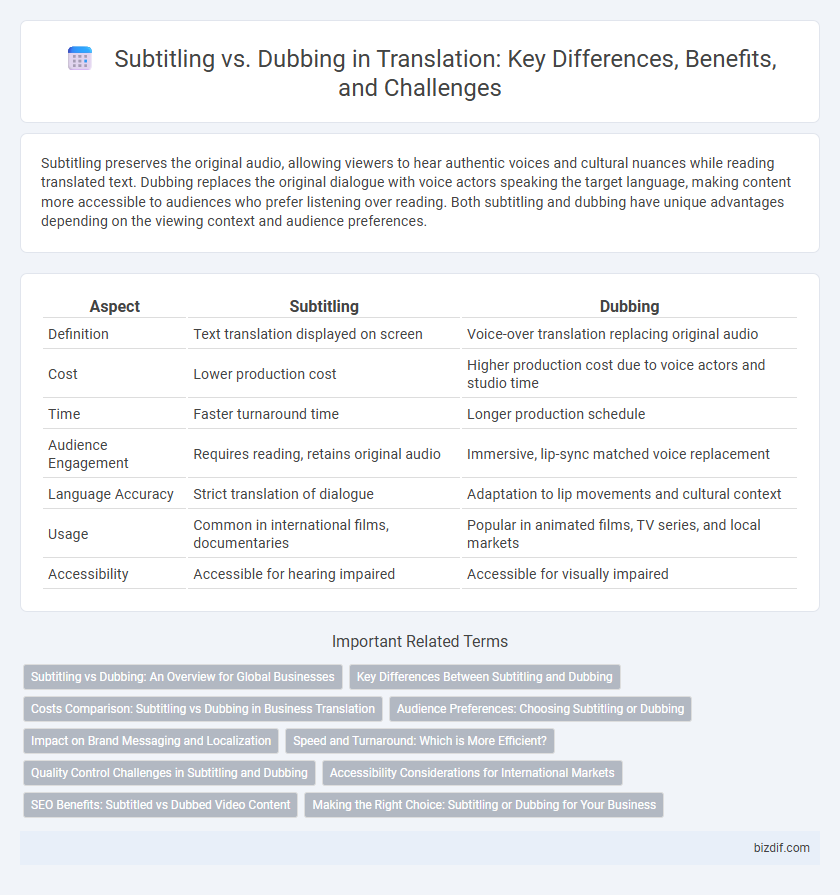Subtitling preserves the original audio, allowing viewers to hear authentic voices and cultural nuances while reading translated text. Dubbing replaces the original dialogue with voice actors speaking the target language, making content more accessible to audiences who prefer listening over reading. Both subtitling and dubbing have unique advantages depending on the viewing context and audience preferences.
Table of Comparison
| Aspect | Subtitling | Dubbing |
|---|---|---|
| Definition | Text translation displayed on screen | Voice-over translation replacing original audio |
| Cost | Lower production cost | Higher production cost due to voice actors and studio time |
| Time | Faster turnaround time | Longer production schedule |
| Audience Engagement | Requires reading, retains original audio | Immersive, lip-sync matched voice replacement |
| Language Accuracy | Strict translation of dialogue | Adaptation to lip movements and cultural context |
| Usage | Common in international films, documentaries | Popular in animated films, TV series, and local markets |
| Accessibility | Accessible for hearing impaired | Accessible for visually impaired |
Subtitling vs Dubbing: An Overview for Global Businesses
Subtitling preserves the original audio, ensuring cultural authenticity and reducing localization costs, while dubbing involves replacing the original dialogue with voice-over in the target language, enhancing viewer engagement and accessibility. Global businesses must weigh factors such as budget, target audience preferences, and content type when choosing between the two methods for effective international marketing. Subtitling offers faster turnaround and lower expenses, making it ideal for large-scale, multilingual campaigns, whereas dubbing provides a more immersive experience, particularly for entertainment and educational content.
Key Differences Between Subtitling and Dubbing
Subtitling translates spoken dialogue into written text displayed on screen, preserving original audio and actors' performances, while dubbing replaces the original audio with voice actors speaking the target language, creating a more immersive experience for viewers who prefer listening over reading. Subtitling tends to be more cost-effective and faster to produce, whereas dubbing requires extensive synchronization, voice casting, and studio recording. Subtitling is favored in markets valuing authenticity and original speech, while dubbing dominates in regions prioritizing accessibility and ease of viewing, such as children's programming or audiences with reading difficulties.
Costs Comparison: Subtitling vs Dubbing in Business Translation
Subtitling generally incurs lower costs compared to dubbing, primarily because it requires fewer specialized resources such as voice actors and sound engineers. Dubbing demands a more complex production process, increasing expenses related to recording, synchronization, and post-production. Businesses often choose subtitling to maximize budget efficiency in translation while maintaining accessible content for diverse audiences.
Audience Preferences: Choosing Subtitling or Dubbing
Audience preferences between subtitling and dubbing vary significantly based on cultural and linguistic factors. In regions with high literacy rates and multilingual populations, subtitling is often favored for preserving original audio quality and actor performance. Conversely, dubbing is preferred in markets where viewers prioritize seamless audio-visual synchronization and ease of comprehension, especially among younger or less literate audiences.
Impact on Brand Messaging and Localization
Subtitling preserves the original audio, maintaining the authentic cultural tone while allowing brand messaging to reach a wider audience with precise localization. Dubbing adapts voice and language fully, creating a more immersive experience that can strengthen emotional connection and brand identity in target markets. Balancing subtitling and dubbing strategies depends on the desired impact on brand perception and the cultural nuances of the localized content.
Speed and Turnaround: Which is More Efficient?
Subtitling offers faster turnaround times since it only requires translating and syncing text to dialogue, making it ideal for quick releases. Dubbing involves complex processes like voice casting, recording, and audio mixing, significantly extending production time. Consequently, subtitling proves more efficient in speed and turnaround for content localization.
Quality Control Challenges in Subtitling and Dubbing
Quality control challenges in subtitling include accurate timing synchronization, maintaining readability within limited space, and preserving cultural nuances without altering the original meaning. Dubbing quality control requires voice actor performance consistency, lip-sync precision, and careful audio mixing to ensure dialogues match the original tone and emotion. Both processes demand rigorous linguistic review and technical checks to meet viewer expectations and maintain content integrity.
Accessibility Considerations for International Markets
Subtitling and dubbing both enhance accessibility in international markets by catering to varied audience preferences and linguistic abilities. Subtitling preserves original audio, benefiting hearing-impaired viewers and those seeking language learning support, while dubbing offers a fully localized experience suited for audiences with reading difficulties or young children. Choosing the right method depends on target demographics, cultural context, and budget constraints to maximize global reach and viewer engagement.
SEO Benefits: Subtitled vs Dubbed Video Content
Subtitled video content enhances SEO by allowing search engines to index spoken dialogue through accurate text transcription, increasing keyword relevance and discoverability. Dubbing, while improving viewer engagement by offering native-language audio, provides limited SEO benefits as the original dialogue remains untranslated in metadata. Optimizing subtitles with targeted keywords boosts video accessibility and search rankings, making subtitling a preferred strategy for maximizing online visibility.
Making the Right Choice: Subtitling or Dubbing for Your Business
Choosing between subtitling and dubbing depends on your target audience's preferences, budget constraints, and the content's cultural nuances. Subtitling offers a cost-effective solution that preserves original audio, ideal for markets valuing authenticity and quick turnaround. Dubbing enhances viewer engagement through localized voice performances, making it suitable for brands aiming for immersive experiences in languages with high audiovisual consumption.
Subtitling vs Dubbing Infographic

 bizdif.com
bizdif.com